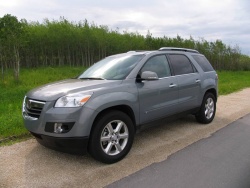 2007 Saturn Outlook XR. Click image to enlarge |
|
Related articles on Autos
Manufacturer’s web site
|
By Chris Chase; photos by Haney Louka
The Saturn Outlook was introduced in 2007 as the brand’s first full-size crossover vehicle. It was built on the General Motors Lambda platform which also underpinned the 2007 GMC Acadia and 2008 Buick Enclave and Chevrolet Traverse. In the cases of Saturn, Chevrolet and Buick, these trucks were intended to replace slow-selling minivans – the Relay, in Saturn’s case. The Outlook disappeared, along with the rest of the Saturn line, when GM discontinued it after the 2009 model year.
The Outlook followed the modern crossover formula, using a V6 engine powering either the front wheels alone, or all four through an automatic all-wheel drive system that powers the fronts only until extra traction is needed. The engine displaced 3.6 litres and made 265 horsepower and 244 lb-ft of torque, or 267 hp/247 lb-ft with the uplevel XR model’s dual exhaust. The sole transmission offered was a six-speed automatic, and in 2008, power outputs increased to 270 hp/248 lb-ft in the XE and 275 hp/251 lb-ft in the XR. The 2009 model got another nominal power boost, thanks to a new version of the 3.6-litre engine with variable valve timing and direct fuel injection, to 281hp/266 lb-ft for the XE and 288 hp/270 lb-ft for the XR.
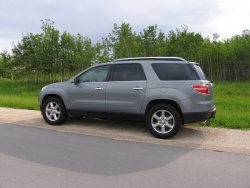 2007 Saturn Outlook XR. Click image to enlarge |
Natural Resources Canada’s fuel consumption estimates were 13.0/8.3 L/100 km (city/highway) for the base XE and 13.5/8.9 for the XR. The 2009’s direct-injected motor did a little better at the pumps, rating 12.7/8.4 L/100 km in XE trim, and 13.1/8.8 in uplevel XR guise.
So far, there appear to be a couple of relatively minor mechanical issues. GM began offering to reprogram the electronic transmission control modules after many owners complained of weird shifting. In fact, the “problem” had to do with a conservative shift program designed to maximize fuel economy. The result was a vehicle that felt sluggish and often wouldn’t downshift in response to normal pressure on the gas pedal, but would respond with a delayed two-gear downshift and more aggressive acceleration than the driver had wanted. Here’s a link to a Technical Service Bulletin (TSB) issued to address the problem. There are a number of other threads on SaturnFans.com and AcadiaForum.net discussing the weird habits of these trucks’ transmissions.
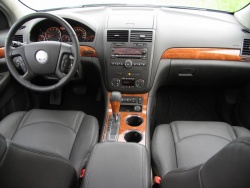 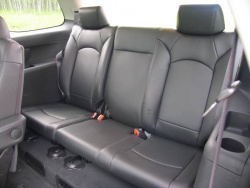 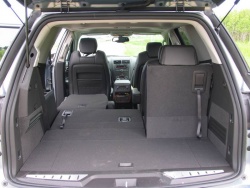 2007 Saturn Outlook XR. Click image to enlarge |
The power steering pump is failure prone, and will announce its impending demise by making a lot of noise.
The Outlook’s sunroofs (sunrooves?) often leak; here’s a snippet from one owner’s experience.
Consumer Reports notes problems with the “windshield motor/washer,” which might be related to GM having to recall, and then remove, a heated windshield washer system that proved to be a fire risk.
Beyond that, look out for annoying problems related to power seats that quit working and troubles with navigation and stereo systems. Overall, Consumer Reports gives the Outlook an average reliability rating in front-wheel drive form, and below average with all-wheel drive.
The Outlook scored well in Insurance Institute for Highway Safety (IIHS) crash tests, earning the organization’s “good” rating in frontal offset and side crashes. It also earned five stars in all categories (driver and front passenger protection in frontal impact, and front and rear seat occupant protection in side impact) from the National Highway Traffic Safety Administration (NHTSA).
Used Outlook values, according to Canadian Black Book, start at $18,150 for a 2007 XE front-wheel drive model and top out at $32,325 for a 2009 XR AWD with all the extras (leather, sunroof, navigation, DVD entertainment system, power liftgate and quad seating). Strip away all the goodies and the same truck is worth $28,625.
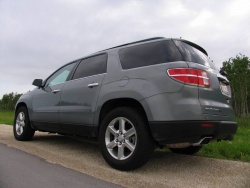 2007 Saturn Outlook XR. Click image to enlarge |
Those prices make the Outlook a good value against better-known import competitors like the Toyota Highlander or Honda Pilot, and even against its platform mates from Chevrolet, GMC and Buick, all of which come in with higher recommended used prices. Despite that, I’d think twice about the Outlook, given that the problems it has experienced aren’t limited to first-year models, according to Consumer Reports. These are nicely-designed trucks, and the problems aren’t serious mechanical flaws but point to poor build quality that could plague the vehicle throughout its service life, and so are worthy of wariness. If you must have an Outlook, shop for a simple one, avoiding models fitted with extras like the sunroofs and extraneous electronics.
|
Pricing
Black Book Pricing (avg. retail) October 2010:
Online resources
Recalls
2009-2010: On certain vehicles, the second row seat side trim shield may restrict the upward rotation of the safety belt buckle when the seat back is returned to a seating position after being folded flat. If the buckle contacts the seat frame, additional effort is required to return the seat to a seating position. If sufficient force is applied, the buckle cover could be pushed down the strap, exposing and partially depressing the red release button. As a result, the release button will not travel as much as designed when depressed and will appear to be jammed. The buckle cover may have visible damage which may only be cosmetic, but in some cases, the buckle may not latch/unlatch, or may appear to latch when the latch mechanism is not fully engaged. If the latch mechanism is not fully engaged, the safety belt may not restrain the occupant as intended in a crash, which could result in personal injury or death. Correction: Dealers will modify the second row seat side trim shields, inspect the belt buckle and will replace it if damaged.Transport Canada Recall Number: 2010189; Units affected: 99,000 (includes other models) 2007-2009: On certain vehicles equipped with a Heated Washer Fluid System (HWFS), a short circuit on the printed circuit board for the washer fluid heater may overheat the control-circuit ground wire. A repair was implemented in a recall in 2008, however, there have been new reports of thermal incidents on heated washer fluid system modules after this improvement was installed. This situation may cause some minor distortion, but also could lead to melting of the plastic around the heated washer fluid system, or potentially a fire. Correction: Dealer will permanently disable and remove the heated washer fluid module. An updated page will be provided and inserted in the Owner Manual to document the removal of the feature. Transport Canada Recall Number: 2009076; Units affected: 31,458 (includes other models) 2009: On certain vehicles, the transmission shift cable adjustment clip may not be fully engaged. Should this occur, the shift lever and the actual position of the transmission gear may not match. As such, the driver could move the shifter to PARK and remove the ignition key, but the transmission gear may not actually be in the PARK position. This could allow the vehicle to roll away, possibly causing property damage and/or personal injury or death. Correction: Dealers will inspect and, if required, replace the shift cable. Transport Canada Recall Number: 2008424; Units affected: 536 (includes other models) 2009: Certain vehicles fail to comply with the requirements of CMVSS 209 – Seatbelt Assemblies. These vehicles may have been assembled with a safety belt buckle in the second or third row that is missing a rivet. In a vehicle crash, this could allow the buckle to separate from the mounting strap. As a result, the seat occupant may not be restrained as intended, which could cause personal injury or death. Correction: Dealers will inspect the seatbelt buckles in the second and third rows, and replace them if necessary. Transport Canada Recall Number: 2008313; Units affected: 54,431 (includes other models) 2007-2008: On certain vehicles equipped with a heated washer fluid system, a short circuit on the printed circuit board for the washer fluid heater may overheat the control-circuit ground wire. This situation may cause other electrical features to malfunction which could cause smoke and in some cases a fire. Correction: Dealer will install a wire harness with an in-line fuse. Transport Canada Recall Number: 2008283; Units affected: 16,533 (includes other models) 2007-2008: On certain vehicles registered in areas with moderate to heavy snowfall, a build-up of snow or ice on the windshield or wipers could restrict the movement of the wiper arm and the wiper linkage may become detached from motor shaft and the wipers will become inoperative. This situation, in conjunction with traffic, road conditions, and driver’s reactions, could increase the risk of a crash. Correction: Dealers will install a new wiper crank arm, driver’s side link, and crank arm nut. Transport Canada Recall Number: 2007044; Units affected: 1,079 (includes other models) 2007: On certain vehicles, the sensing and diagnostic module (SDM), which controls the function of front airbags, may not operate properly. As a result, the front airbags may fail to deploy in a frontal crash. Also, the airbag warning lamp in the instrument panel may fail to provide warning that the system is inoperative. Failure to deploy the front airbags during a crash could leave seat occupants susceptible to increase injuries. Correction: Dealers will re-program the SDM.
Crash test results
Used vehicle prices vary depending on factors such as general condition, odometer reading, usage history and options fitted. Always have a used vehicle checked by an experienced auto technician before you buy. For information on recalls, see Transport Canada’s web-site, www.tc.gc.ca, or the U.S. National Highway Transportation Administration (NHTSA)web-site, www.nhtsa.dot.gov. For information on vehicle service bulletins issued by the manufacturer, visit www.nhtsa.dot.gov. For information on consumer complaints about specific models, see www.lemonaidcars.com. |







 Follow Autos on Twitter
Follow Autos on Twitter



